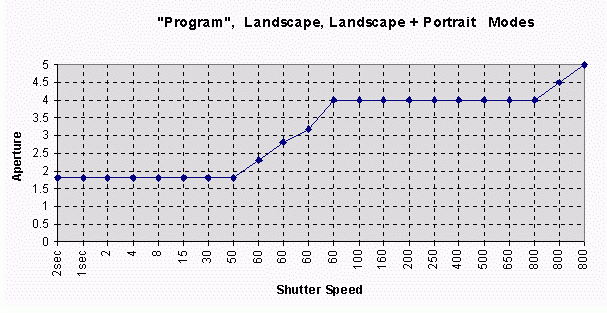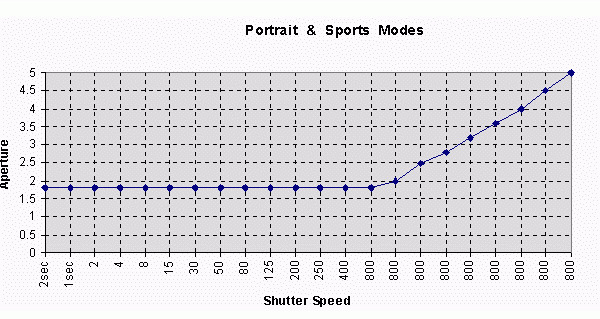

An Evaluation of Automatic
Exposure Characteristics & Scene Modes
By Alan Fleming
| Back to the Olympus 5050 online resource | Olympus 5050 users group |
Introduction :-
Modern cameras often have a number of "automatic exposure modes" intended to help the photographer get the best pictures without worrying too much about some of the technicalities and effects of shutter speeds and aperture values. The Olympus C5050 Zoom is no exception and has a "Program Mode" (labelled P) and a number of Scene Modes (including Portrait, Sports, Landscape, Landscape + Portrait, Night). Whilst it is often convenient to let the camera select the "best combination" of aperture and shutter speed for a given user selected "Mode" it is also an advantage to have some idea of the way the camera is "programmed" to select the "best combination".
This document gives the details of a simple
evaluation of the various daylight "Modes" of the Olympus C5050Z and the
findings of the measurements. These results must only be treated as a simple
comparison of the exposure characteristics of the relevant "Modes" - there
are clearly many other complex "in camera" scene evaluations and processing
per mode which are not taken into account with this crude method of comparison
measurements.
The Camera Settings :-
The following camera settings were used throughout all of the measurements :-
1) The Light Source :-
A standard 35mm slide projector with the
AC supply via a "light dimmer". Light, through an empty slide carrier,
projected onto a " "bright white" screen at approx. 1 metre from the projector.
The light intensity was varied from off to full intensity using the AC
"light dimmer".
2) Camera :-
The Olympus C5050 Zoom camera was mounted
on a tripod approx. 1 metre from projector screen. The Camera LCD screen
was used throughout. The LCD focus / exposure mark was positioned to be
in the middle of the projected bright area. Camera settings were as stated
above. NOTE - Camera "White Balance" was left on "Auto" setting even though
the light characteristics were from a tungsten lamp. A quick evaluation
of changing the white balance setting did not seem to make any difference
!
3) Measurements :-
The light intensity was increased slowly
with the camera set to "Program - P" Mode. The camera LCD exposure value
reading was noted and the light value increase stopped at every stable
reading. The "P" exposure values were noted. The camera mode dial was then
switched to each other Mode and the exposure readings noted. After switch
back to "P" the light was then increased to next stable reading.
Repeated until maximum light available.
All readings repeated to confirm measurement repeatability.
The Results :-
The readings of Shutter Speed and Aperture
were obtained for varying light intensity for the "Modes" of "Program =
P", "Portrait", "Sports", "Landscape + Portrait", & "Landscape". The
"Night" mode was not measured. The results are presented in a graphical
form. The detailed numerical results table is at the end of this document.
Observations and Conclusions :-
For the camera settings as stated above -
A graphical representation of the results
:-


Detailed Results Table :-
Measurements taken using variable light
source and noting camera exposure readings in each mod. Increments determined
by watching for stable exposure value readings on camera LCD in "P" Mode.
| "Program
- P"
Mode |
Portrait
Mode |
Sports
Mode |
Landscape + Portrait Mode | Landscape
Mode |
||||||||||
| 2sec | f1.8 | 2sec | f1.8 | 2sec | f1.8 | 2sec | f1.8 | 2sec | f1.8 | |||||
| 1sec | f1.8 | 1sec | f1.8 | 1sec | f1.8 | 1sec | f1.8 | 1sec | f1.8 | |||||
| 1/2 | f1.8 | 1/2 | f1.8 | 1/2 | f1.8 | 1/2 | f1.8 | 1/2 | f1.8 | |||||
| 1/8 | f1.8 | 1/8 | f1.8 | 1/8 | f1.8 | 1/8 | f1.8 | 1/8 | f1.8 | |||||
| 1/15 | f1.8 | 1/15 | f1.8 | 15 | f1.8 | 1/15 | f1.8 | 1/15 | f1.8 | |||||
| 1/30 | f1.8 | 1/30 | f1.8 | 1/30 | f1.8 | 1/30 | f1.8 | 1/30 | f1.8 | |||||
| 1/50 | f1.8 | 1/50 | f1.8 | 1/50 | f1.8 | 1/50 | f1.8 | 1/50 | f1.8 | |||||
| 1/60 | f2.3 | 1/80 | f1.8 | 1/80 | f1.8 | 1/60 | f2.3 | 1/60 | f2.3 | |||||
| 1/60 | f2.8 | 1/125 | f1.8 | 1/125 | f1.8 | 1/60 | f2.8 | 1/60 | f2.8 | |||||
| 1/60 | f3.2 | 1/200 | f1.8 | 1/200 | f1.8 | 1/60 | f3.2 | 1/60 | f3.2 | |||||
| 1/60 | f4 | 1/250 | f1.8 | 1/250 | f1.8 | 1/60 | f4 | 1/60 | f4 | |||||
| 1/100 | f4 | 1/400 | f1.8 | 1/400 | f1.8 | 1/100 | f4 | 1/100 | f4 | |||||
| 1/160 | f4 | 1/800 | f1.8 | 1/800 | f1.8 | 1/160 | f4 | 1/160 | f4 | |||||
| 1/200 | f4 | 1/800 | f2 | 1/800 | f2 | 1/200 | f4 | 1/200 | f4 | |||||
| 1/250 | f4 | 1/800 | f2.6 | 1/800 | f2.6 | 1/250 | f4 | 1/250 | f4 | |||||
| 1/400 | f4 | 1/800 | f2.8 | 1/800 | f2.8 | 1/400 | f4 | 1/400 | f4 | |||||
| 1/500 | f4 | 1/800 | f3.2 | 1/800 | f3.2 | 1/500 | f4 | 1/500 | f4 | |||||
| 1/650 | f4 | 1/800 | f3.6 | 1/800 | f3.6 | 1/650 | f4 | 1/650 | f4 | |||||
| 1/800 | f4 | 1/800 | f4 | 1/800 | f4 | 1/800 | f4 | 1/800 | f4 | |||||
| 1/800 | f4.5 | 1/800 | f4.5 | 1/800 | f4.5 | 1/800 | f4.5 | 1/800 | f4.5 | |||||
| 1/800 | f5 | 1/800 | f5 | 1/800 | f5 | 1/800 | f5 | 1/800 | f5 | |||||
Disclaimer :-
This document and these results were compiled by Alan Fleming, Glossop, Derbyshire, UK.
All the results given and
any opinions expressed or implied are solely those of the author.
Issue 2.1 7th
April 2003